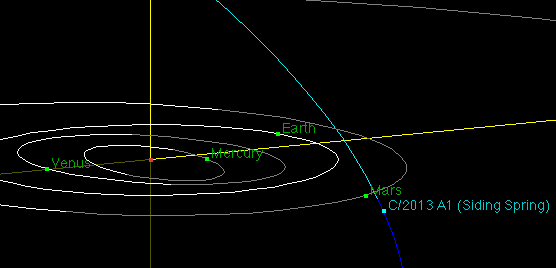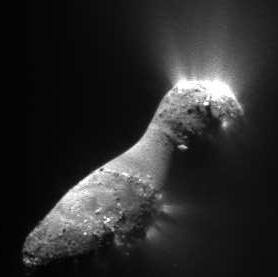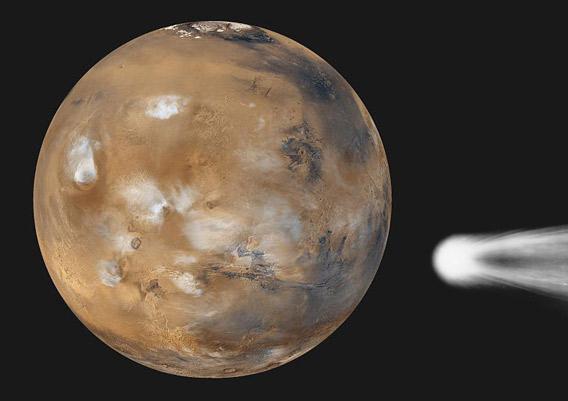In case you just can’t get enough impact news, it looks like Mars may actually get hit by a comet in 2014! As it stands right now, the chance of a direct impact are small, but it’s likely Mars will get pelted by the debris associated with the comet.
I know. This is pretty amazing. Still, let me preface this with a caveat: Trying to get precise predictions of comet orbits can be difficult, and for this one we’re talking about a prediction for 20 months from now! Things may very well change, but here’s what we know so far.
Comet What May
The comet is called C/2013 A1 (Siding Spring), discovered on Jan. 3, 2013 by the Australian veteran comet hunter Robert McNaught. As soon as it was announced, astronomers at the Catalina Sky Survey looked at their own data and found it in observations from Dec. 8, 2012, which helped nail down the orbit (I explain how that works in a previous article about asteroid near-misses). Extrapolating its orbit, they found it will make a very near pass of Mars around Oct. 19, 2014, missing the planet by the nominal distance of about 100,000 kilometers (60,000 miles).
Observations taken at the ISON-NM observatory in New Mexico just this week have tightened up the orbit a bit more, allowing for better predictions. Given this new data, the comet may actually pass closer to Mars; another veteran comet hunter, Leonid Elenin, predicts it may get as close as 37,000 km (23,000 miles) of the surface of Mars!
That’s pretty dang close. But this gets even more interesting.

Image credit: NASA/JPL
Ice to See You
Comets are similar to asteroids: Big chunks of interplanetary debris, mostly rock, that orbit the Sun. Comets, though, have a lot of ice in them—what we normally think of as gases and liquids on Earth like carbon dioxide, carbon monoxide, and water. But in deep space, these are frozen (making up much of the solid part of a comet, called the nucleus). As the comet nears the Sun it warms up, and these substances sublimate; that is, turn directly from a solid into a gas. They can exist on and below the comet’s surface, so when they sublimate they can erupt from vents like geysers. These vents act like rockets, gently pushing on the comet nucleus. Over time, this can change the comet’s orbit a bit, which is why I said above that making accurate predictions of a comet’s position over very long periods of time can be difficult.

Right now, the comet is over a billion kilometers from the Sun, and is (pardon the expression) stone cold. Still, a small amount of coma activity has been seen (see the picture below), and as it gets closer over the next year or so, it may very well vent more gas. If it does, its orbit may change enough to push it farther from Mars. Or it may push it right into the planet’s path. We won’t know for sure until at least late summer 2013, when more observations are possible (it’s about to get too close to the Sun from our viewpoint here on Earth to observe).
Let me be very clear: We are in no danger here on Earth. The nudges in orbit I’m talking about are pretty small, and it will be many millions of kilometers from Earth at closest. We’re safe.
Slipping into the Coma
And there’s still more. Comets aren’t generally very solid; you can think of them as loose piles of rubble held together by those ices. As the ice sublimates, the comet dissolves a little, and that rubble can escape. This material, usually objects the size of grains of sand up to small rocks, orbit along very nearly the same path as the comet nucleus itself (which is why we get meteor showers). The gas expands into a large fuzzy cloud around the nucleus, called the coma (which is Latin for hair). Although the nucleus may be a few kilometers in diameter, the coma can be several hundred thousand kilometers across!
What makes this so very interesting is that the coma can be bigger than the predicted distance by which the comet will pass Mars. This means it’s entirely possible, even likely, Mars will pass right through this cloud of material. And the closer the comet gets, the more likely it is Mars will get pelted by the debris set loose from the nucleus itself.
If that does happen, it’ll be the gods’ own meteor shower for the red planet.
I’m not entirely sure what we’ll be able to see from Earth should this happen. Mars will be well-placed in the night sky, so we’ll have a decent view. But most of the debris would be pretty small, so the odds of seeing much are low. Plus, there will be a big honking fuzzy comet in the way, obscuring the view!
Mars has two small moons, potato-shaped lumps a few kilometers across. I’ll be very curious to see comparisons of before-and-after pictures, to see if they get any new impacts on them.
Deep Impact
If the nucleus does hit the planet, well.
That will be amazing, and by “amazing” I mean “apocalyptic”. The nucleus size is not well known, but may be as small as 15 kilometers (9 miles) or as big as 50 km (30 miles). Even using the small number means Mars would be slammed by an unimaginable impact. The comet is orbiting the Sun backward (more on that in a second), so it will be moving at a speed of about 55 kilometers per second (120,000 miles per hour!) upon impact. That means the comet has a huge amount of kinetic energy, the energy of motion. That energy will be released at impact as an explosion. A big one.
A really big one.
Doing a rough calculation, I get an explosive yield of roughly one billion megatons: That’s a million billion tons of TNT exploding. Or, if you prefer, an explosion about 25 million times larger than the largest nuclear weapon ever tested on Earth.
So, yeah.
The crater left behind would be hundreds of kilometers across, and be the largest impact Mars has seen in a long, long time. Mind you, once again, there is no guarantee this comet will hit Mars. The most likely scenario is a close pass, which is still incredible.
In one sense, an impact would be pretty bad for us on Earth: we’d almost certainly lose all our robotic probes in orbit and on the surface. An impact that size would blast debris all over the planet, and the rovers could be damaged or destroyed. Even something in orbit wouldn’t be safe; the ejecta would come screaming off the planet and sent every which way in orbit around Mars. It would be like orbiting into a shotgun blast.
Even a near miss may prove dangerous for the probes, since as I pointed out there will be debris anyway. If we’re lucky, they’ll make it through this just fine, and we may very well get some spectacular images from them (as usual, Emily Lakdawalla at The Planetary Society Blog has that story). We’ll just have to wait and see what happens over the next few months.

Image credit: Carl Hergenrother
Grabbing a Comet by the Tail
Even if this comet weren’t getting anywhere near Mars, it’s worth studying. For one thing, as far as we can tell right now its orbit is hyperbolic. Assuming the observations are accurate, that means that it’s actually traveling faster than the Sun’s escape velocity. It probably came from very deep space, well outside the orbit the Neptune, probably from the vast cloud of comets surrounding the Sun called the Oort cloud. It may have gotten a kick from some outer planet (Jupiter is the usual culprit), giving it a bit of extra speed.
This is pretty rare, with only a few dozen comets known with hyperbolic trajectories. If it survives the encounter with Mars, it’ll head back out into deep space, almost certainly never to return. This will be our only chance to observe it.
And what will this look like late next year, when the comet is so close to Mars in space as well as in our sky? It’s hard to say, but the comet may actually be brighter; the gas particles are highly reflective, and may form a cloud far larger than Mars itself. So what we might see is a bright dot (or maybe even a disk if the coma is large enough), slowly encroaching on the ruddy bright star-like point of Mars. Over the course of a few weeks they’ll get closer, and closer…and for a day or so you might actually need a telescope to separate the two.
And then my best guess is that we’ll then see them pull apart, as the comet heads back out into the frozen vault of deep space, with Mars little worse for the wear.
But we’ll see.
